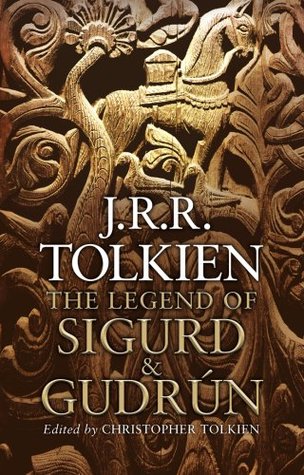Copyright: Bookshelf Fantasies
The Shelf Control Meme was created and is hosted by Book Shelf Fantasies.
Shelf Control is a weekly celebration of the unread books on our shelves. Pick a book you own but haven't read, write a post about it, and link up!
⤧ ⤧ ⤧ ⤧ ⤧ ⤧
My Shelf Control pick this week is:
Title: The Legend of Sigurd and Gudrun
Author: J.R.R. Tolkien and Christopher Tolkien
Published: May 5, 2009
Length: 377 pages
What it's about (synopsis via Goodreads): Many years ago, J.R.R. Tolkien composed his own version now published for the first time, of the great legend of Northern antiquity, in two closely related poems to which he gave the titles The New Lay of the Volsungs and The New lay of Gudrun. In the "Lay of the Volsungs" is told the ancestry of the great hero Sigurd, the slayer of Fafnir most celebrated of dragons, whose treasure for his own; of his awakening of the Valkyrie Brynhild, who slept surrounded by a wall of fire, and of their betrothal; and of his coming to the court of the great princes who were named the Niflungs (or Nibelungs), with whom he entered into blood-brotherhood. In that court, there sprang great love but also great hate, brought about by the power of the enchantress of the Niflungs, skilled in the arts of magic, of shape-changing and potions of forgetfulness.
In scenes of dramatic intensity, of confusion of identity, thwarted passion, jealousy, and bitter strife, the tragedy of Sigurd and Brynhild, of Gunnar the Niflung and Gudrun his sister, mounts to its end in the murder of Sigurd at the hands of his blood-brothers, the suicide of Brynhild, and the despair of Gudrun. In the "Lay of Gudrun" her fate after the death of Sigurd is told, her marriage to the mighty Atli, ruler of the Huns (the Attila of history), his murder of her brothers the Niflung lords, and her hideous revenge.
Deriving his version primarily from his close study of the ancient poetry of Norway and Iceland known as the Poetic Edda (and where no old poetry exists, from the later prose work Volsunga Saga), J.R.R Tolkien employed a verse-form of short stanzas whose lines embody in English the exacting alliterative rhythms and the concentrated energy of the poems of the Edda.
How I got it:
I happened to have bought this interesting book from the local Dollar Tree for a dollar. I'm glad to have bought this book.
When I got it:
I do believe I bought this book last year.
Why I want to read it:
I want to read it because it has connections to the Poetic Edda. I haven't read the Poetic Edda yet either but I really like Norse things.


No comments:
Post a Comment